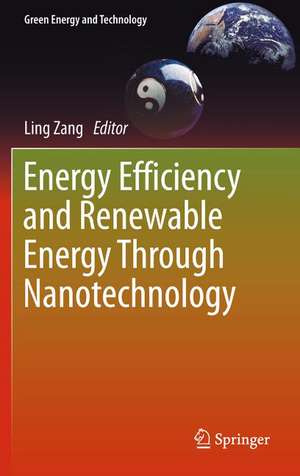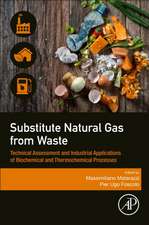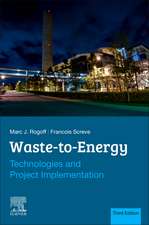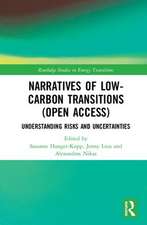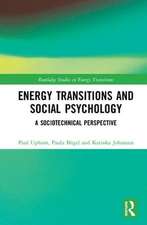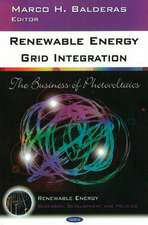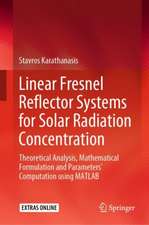Energy Efficiency and Renewable Energy Through Nanotechnology: Green Energy and Technology
Editat de Ling Zangen Limba Engleză Hardback – 7 sep 2011
Energy Efficiency and Renewable Energy Through Nanotechnology tightly correlates nanotechnology with energy issues in a general, comprehensive way that makes it not only suitable as a desk reference for research, but also as a knowledge resource for the non-expert general public.
Readers will find Energy Efficiency and Renewable Energy Through Nanotechnology useful in a variety of ways, ranging from the creation of energy policy, to energy research development, and to education in nanotechnology and its application to energy-related problems. It can also be used as a primary or supplementary textbook for energy-related courses for advanced undergraduate and graduate students.
| Toate formatele și edițiile | Preț | Express |
|---|---|---|
| Paperback (1) | 1847.03 lei 43-57 zile | |
| SPRINGER LONDON – 23 aug 2016 | 1847.03 lei 43-57 zile | |
| Hardback (1) | 1851.77 lei 43-57 zile | |
| SPRINGER LONDON – 7 sep 2011 | 1851.77 lei 43-57 zile |
Din seria Green Energy and Technology
- 18%
 Preț: 943.43 lei
Preț: 943.43 lei - 20%
 Preț: 629.52 lei
Preț: 629.52 lei - 18%
 Preț: 1124.92 lei
Preț: 1124.92 lei - 18%
 Preț: 947.35 lei
Preț: 947.35 lei - 15%
 Preț: 655.92 lei
Preț: 655.92 lei - 18%
 Preț: 957.62 lei
Preț: 957.62 lei - 18%
 Preț: 789.52 lei
Preț: 789.52 lei - 17%
 Preț: 464.55 lei
Preț: 464.55 lei - 15%
 Preț: 645.79 lei
Preț: 645.79 lei - 18%
 Preț: 903.93 lei
Preț: 903.93 lei - 24%
 Preț: 1322.07 lei
Preț: 1322.07 lei - 18%
 Preț: 890.54 lei
Preț: 890.54 lei - 18%
 Preț: 1115.46 lei
Preț: 1115.46 lei - 18%
 Preț: 1117.03 lei
Preț: 1117.03 lei - 18%
 Preț: 949.73 lei
Preț: 949.73 lei - 18%
 Preț: 892.11 lei
Preț: 892.11 lei - 15%
 Preț: 648.24 lei
Preț: 648.24 lei - 18%
 Preț: 997.09 lei
Preț: 997.09 lei - 15%
 Preț: 579.81 lei
Preț: 579.81 lei - 18%
 Preț: 1123.15 lei
Preț: 1123.15 lei - 18%
 Preț: 961.41 lei
Preț: 961.41 lei - 17%
 Preț: 490.22 lei
Preț: 490.22 lei - 18%
 Preț: 904.60 lei
Preț: 904.60 lei - 15%
 Preț: 643.34 lei
Preț: 643.34 lei -
 Preț: 287.90 lei
Preț: 287.90 lei - 24%
 Preț: 634.04 lei
Preț: 634.04 lei -
 Preț: 379.39 lei
Preț: 379.39 lei - 18%
 Preț: 783.20 lei
Preț: 783.20 lei - 18%
 Preț: 1394.84 lei
Preț: 1394.84 lei - 18%
 Preț: 1691.57 lei
Preț: 1691.57 lei - 18%
 Preț: 1112.48 lei
Preț: 1112.48 lei - 15%
 Preț: 592.61 lei
Preț: 592.61 lei - 18%
 Preț: 952.09 lei
Preț: 952.09 lei - 18%
 Preț: 944.19 lei
Preț: 944.19 lei - 18%
 Preț: 891.33 lei
Preț: 891.33 lei - 18%
 Preț: 1252.44 lei
Preț: 1252.44 lei - 18%
 Preț: 789.52 lei
Preț: 789.52 lei - 20%
 Preț: 566.29 lei
Preț: 566.29 lei - 18%
 Preț: 1113.71 lei
Preț: 1113.71 lei - 18%
 Preț: 1114.24 lei
Preț: 1114.24 lei - 24%
 Preț: 590.58 lei
Preț: 590.58 lei - 20%
 Preț: 567.49 lei
Preț: 567.49 lei - 24%
 Preț: 907.48 lei
Preț: 907.48 lei - 18%
 Preț: 952.89 lei
Preț: 952.89 lei - 18%
 Preț: 952.89 lei
Preț: 952.89 lei - 18%
 Preț: 950.52 lei
Preț: 950.52 lei
Preț: 1851.77 lei
Preț vechi: 2258.26 lei
-18% Nou
Puncte Express: 2778
Preț estimativ în valută:
354.37€ • 367.87$ • 295.49£
354.37€ • 367.87$ • 295.49£
Carte tipărită la comandă
Livrare economică 24 martie-07 aprilie
Preluare comenzi: 021 569.72.76
Specificații
ISBN-13: 9780857296375
ISBN-10: 085729637X
Pagini: 946
Ilustrații: XI, 946 p.
Dimensiuni: 155 x 235 x 53 mm
Greutate: 1.45 kg
Ediția:2011
Editura: SPRINGER LONDON
Colecția Springer
Seria Green Energy and Technology
Locul publicării:London, United Kingdom
ISBN-10: 085729637X
Pagini: 946
Ilustrații: XI, 946 p.
Dimensiuni: 155 x 235 x 53 mm
Greutate: 1.45 kg
Ediția:2011
Editura: SPRINGER LONDON
Colecția Springer
Seria Green Energy and Technology
Locul publicării:London, United Kingdom
Public țintă
ResearchCuprins
1. Enhancement of Si Based Solar Cell Efficiency via Nanostructure Integration.- 2. Organic and Hybrid Solar Cells Based on Small Molecules.- 3. Organic Solar Cells with Inverted and Tandem Structures.- 4. Organic Solar Cells and Their Nanostructural Improvement.- 5. On the Importance of Morphology Control for Printable Solar Cells.- 6. Development of Low Band Gap Polymers for Roll-to-Roll Coated Polymer Solar Cell Modules.- 7. Nanoarchitectured Electrodes for Enhanced Electron Transport in Dye-Sensitized Solar Cells.- 8. Dye-Sensitized Solar Cells Using Natural Dyes and Nanostructural Improvement of TiO2 Film.- 9. Nanotube and Nanorod Based Dye-Sensitized Solar Cells.- 10. Nanostructured Materials by Molecular Layer Deposition for Enhanced Solar Energy Utilization with Optical Waveguides.- 11. Nanomaterials for Proton Exchange Membrane Fuel Cells.- 12. Mechanical Energy Harvesting Based on PZT Nanofibers.- 13. Nanostructured Materials for Photolytic Hydrogen Production.- 14. (Oxy)nitrides and Oxysulfides as Visible-Light-Driven Photocatalysts for Overall Water Splitting.- 15. Heterogeneous Photocatalytic Conversion of Carbon Dioxide.- 16. Nanostructured Electrodes and Devices for Converting Carbon Dioxide Back to Fuels: Advances and Perspectives.- 17. Nitrogen Photofixation at Nanostructured Iron Titanate Films.- 18. Photoreduction of Nitrogen on TiO2 and on TiO2-Containing Minerals.- 19. Photocatalytic Degradation of Water Pollutants Using Nano-TiO2.- 20. Advanced Photocatalytic Nanomaterials for Degrading Pollutants and Generating Fuels by Sunlight.- 21. Lithium-based Batteries for Efficient Energy Storage: Nanotechnology and Its Implications.- 22. Computational Nanostructure Design for Hydrogen Storage.- 23. Use of Nanostructures for High Brightness Light Emitting Diodes.- 24. Dielectric Physics Approach for Improvement of Organic-Field Effect Transistors Performance.- 25. Aerogels for Energy Saving and Storage.- 26. Window Glass Coatings.
Notă biografică
Ling Zang, Ph.D., is a USTAR professor of nanotechnology at the University of Utah, with expertise in the fields of nanomaterials and molecular devices. Dr. Zang’s current research focuses on nanoscale imaging and molecular probing, organic semiconductors and nanostructures, optoelectronic sensors and nanodevices, with the long-term goal of achieving real applications in the areas of national security, renewable energy, and clean environment. Before moving to Utah in 2008, Dr. Zang was an associate professor at Southern Illinois University. He was previously an Alexander von Humboldt Fellow at Erlangen-Nuremberg University in Germany, an NSF CAREER Award winner, and a K. C. Wong Foundation Research Fellow. He also holds an adjunct professorship at the Institute of Chemistry, Chinese Academy of Sciences, Beijing, and serves on the editorial board of several scientific journals including the Journal of Nanoengineering and Nanosystems, the Journal of Nanoscience Letters, and Imaging Science and Photochemistry. Dr. Zang has been awarded various federal grants to support his broad range of research in nanoscience and nanotechnology. Beyond the regular faculty duty on campus, Dr. Zang also remains active in organizing and chairing the nanotechnology sessions of various national and international conferences, e.g., Beckman Frontiers of Science Symposium, National Academy of Sciences, AIChE Annual Meeting, NanoUtah Annual Conference, etc. Dr. Zang earned his B.S. in physical chemistry from Tsinghua University in 1991 and his Ph.D. in chemistry from the Chinese Academy of Sciences in 1995.
Textul de pe ultima copertă
Reflecting the rapid growth of nanotechnology research and the potential impact of the growing energy crisis, Energy Efficiency and Renewable Energy Through Nanotechnology provides comprehensive coverage of cutting-edge research in the energy-related fields of nanoscience and nanotechnology, which aim to improve energy efficiency and the generation of renewable energy.
Energy Efficiency and Renewable Energy Through Nanotechnology tightly correlates nanotechnology with energy issues in a general, comprehensive way that makes it not only suitable as a desk reference for research, but also as a knowledge resource for the non-expert general public.
Readers will find Energy Efficiency and Renewable Energy Through Nanotechnology useful in a variety of ways, ranging from the creation of energy policy, to energy research development, and to education in nanotechnology and its application to energy-related problems. It can also be used as a primary or supplementary textbook for energy-related courses for advanced undergraduate and graduate students.
Energy Efficiency and Renewable Energy Through Nanotechnology tightly correlates nanotechnology with energy issues in a general, comprehensive way that makes it not only suitable as a desk reference for research, but also as a knowledge resource for the non-expert general public.
Readers will find Energy Efficiency and Renewable Energy Through Nanotechnology useful in a variety of ways, ranging from the creation of energy policy, to energy research development, and to education in nanotechnology and its application to energy-related problems. It can also be used as a primary or supplementary textbook for energy-related courses for advanced undergraduate and graduate students.
Caracteristici
Provides cutting-edge research on energy-related nanotechnology Offers a comprehensive look at energy-related nanotechnology as a whole, rather than covering highly-specialised topics Written by international experts in energy-related nanotechnology
